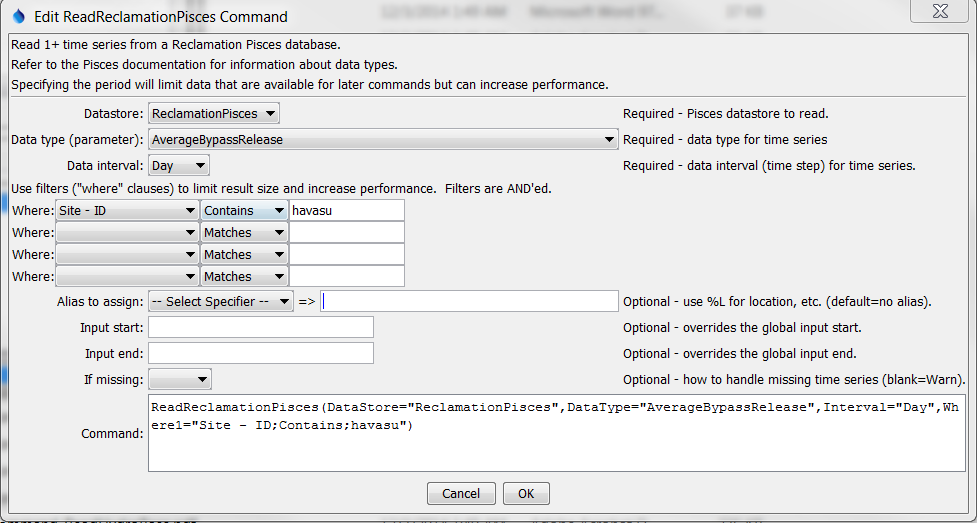TSTool / Command / ReadReclamationPisces
Overview
The ReadReclamationPisces command reads one or more time series from the US Bureau of Reclamation Pisces database
(see the Reclamation Pisces Datastore Appendix).
It is designed to utilize query criteria to process large numbers of time series,
for example for a specific location and parameter type.
The Data type, Data interval, and Where command parameters and input fields are similar to
those from the main TSTool interface.
However, whereas the main TSTool interface first requires a query to find the matching time series list
and then an interactive select for specific time series identifiers,
the ReadReclamationPisces command reads the time series in bulk.
This can greatly shorten command files and simplify command logic, especially when processing many time series.
Command Editor
The following dialog is used to edit the command and illustrates the syntax of the command.

ReadReclamationPisces Command Editor (see also the full-size image)
Command Syntax
The command syntax is as follows:
ReadReclamationPisces(Parameter="Value",...)
Command Parameters
| Parameter | Description | Default |
|---|---|---|
DataStorerequired |
The Reclamation Pisces datastore name to use for the database connection, as per datastore configuration. | None – must be specified. |
DataTyperequired |
The data type (Pisces parameter) to be queried. | None – must be specified. |
Intervalrequired |
The data interval for the time series, consistent with the DataType selection. | None – must be specified. |
WhereN |
When reading 1+ time series, the “where” clauses to be applied. The filters match the values in the Where fields in the command editor dialog and the TSTool main interface. The parameters should be named Where1, Where2, etc., with a gap resulting in the remaining items being ignored. The format of each value is:“Item;Operator;Value”Where Item indicates a data field to be filtered on, Operator is the type of constraint, and Value is the value to be checked when querying. |
If not specified, the query will not be limited and very large numbers of time series may be queried. |
InputStart |
Start of the period to query, specified as a date/time with a precision that matches the requested data interval. Can be specified using ${Property} notation. |
Read all available data. |
InputEnd |
End of the period to query, specified as a date/time with a precision that matches the requested data interval. Can be specified using ${Property} notation. |
Read all available data. |
Alias |
The alias to assign to the time series, as a literal string or using the special formatting characters listed by the command editor. The alias is a short identifier used by other commands to locate time series for processing, as an alternative to the time series identifier (TSID). | No alias will be assigned. |
IfMissing |
Indicate the action to be taken if the requested time series is missing, one of:
|
Warn |
Examples
See the automated tests.
Troubleshooting
See Also
ReadReclamationHDBcommand